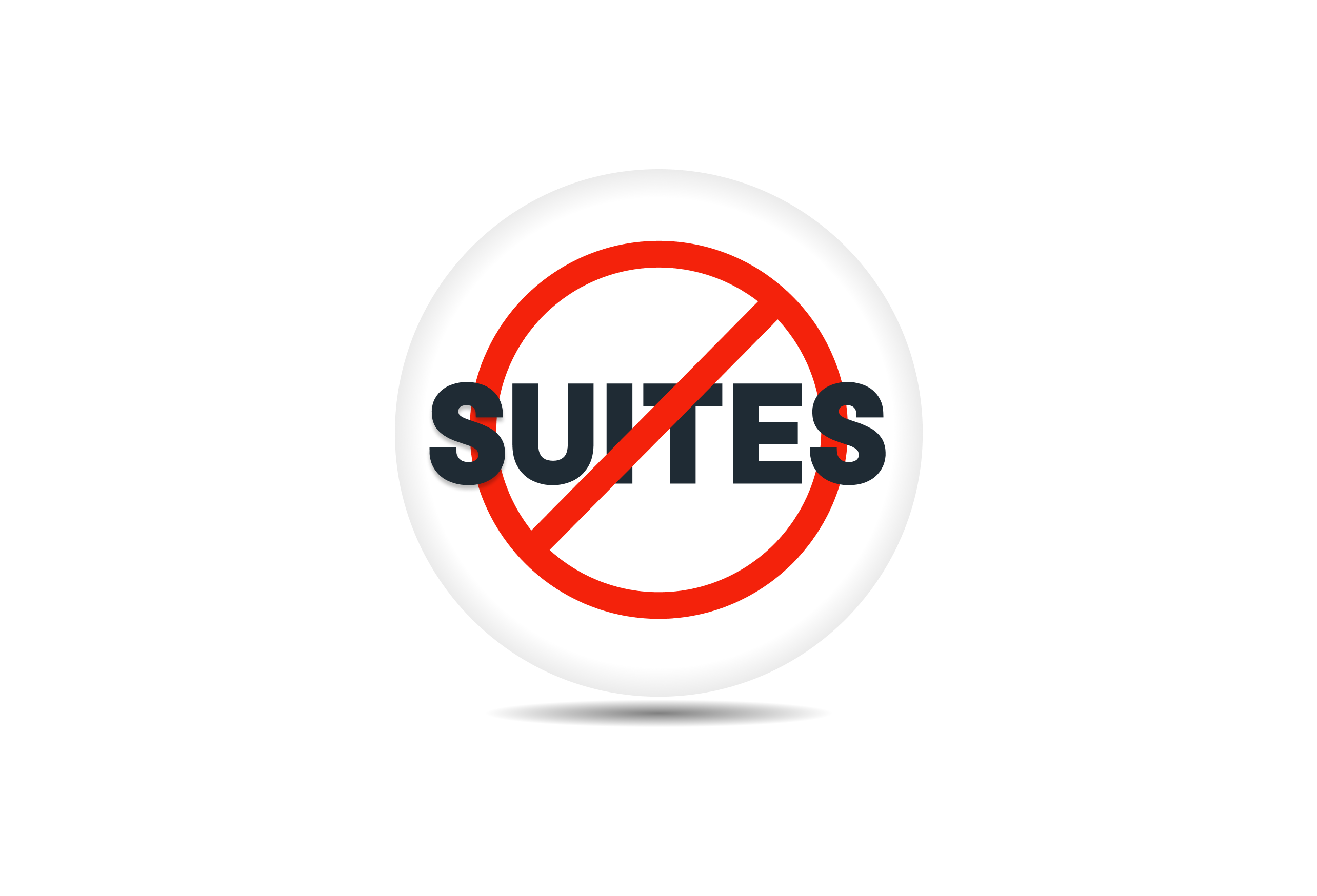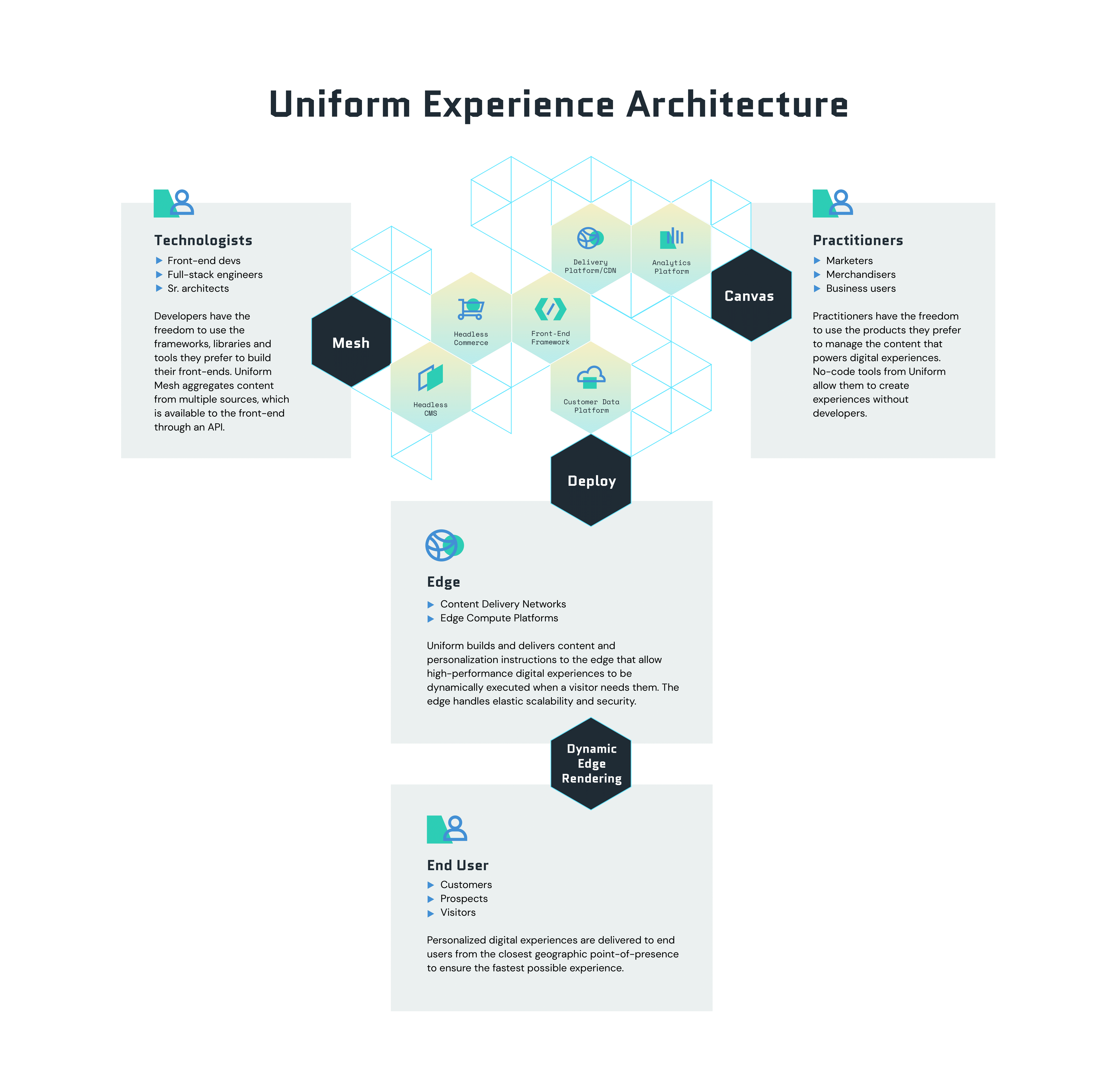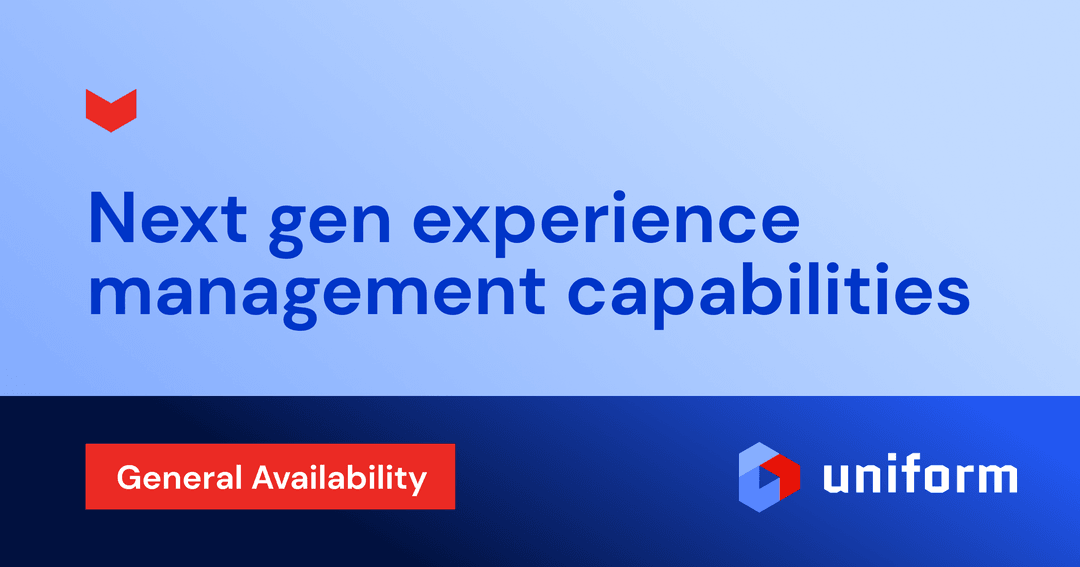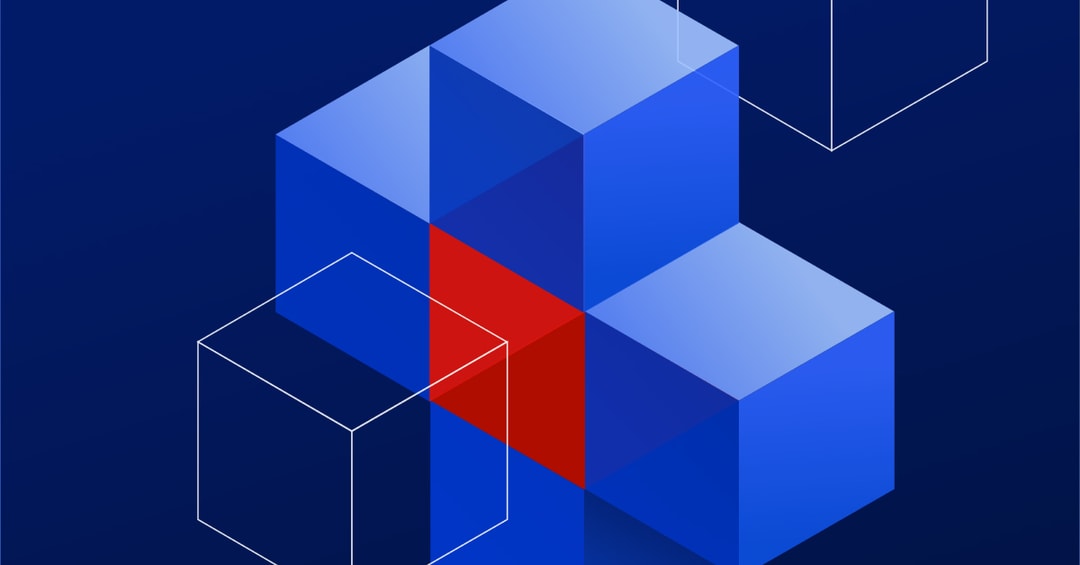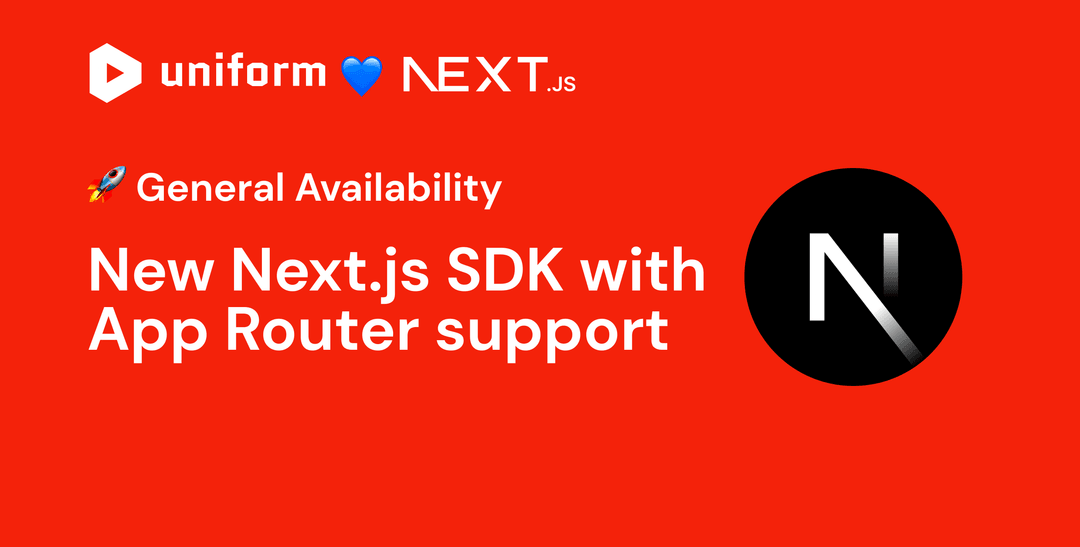Uniform blog/Announcing our Series A: What’s next for Uniform
Announcing our Series A: What’s next for Uniform
Announcing our Series A: What’s next for Uniform
Today we are excited to announce that we've raised a $28 million Series A round led by Insight Partners with participation from Elad Gil and Array Ventures.
As Reid Hoffman has stated: ”starting a company is like jumping off a cliff and assembling a plane on the way down.” As founders, we can only agree with that. Over the past 18 months, we felt like we had been assembling while free falling. Not only have we assembled a plane, but we have also changed the wings, cockpit, and aerodynamics a couple of times. Today we have a new plane, and with the investment, we can add acceleration, going from glider to jetplane. Having a partner like Insight Partners gives us the best engine to accelerate our future growth.
Uniform is on a mission to transform the digital delivery pipeline at every stage.
We want to make it as simple and fast as possible for enterprises to launch the fastest websites and web apps. We want to give developers the freedom to both use the tools they love and add new tools as they emerge. And we want to empower marketers and merchants to create blazing fast hyper-personalizable digital experiences for their customers that result in better engagement and more conversions.
So what is the digital delivery pipeline?
With the rise of decoupled point solutions like headless CMS, headless commerce, or even CDN, it can be easy to forget that these solutions all exist to achieve a single goal - getting valuable digital content to an end user. Together, all the steps required to continually publish and optimize digital experiences are your digital pipeline:
1. Building and connecting the underlying headless infrastructure
2. Creating the content driving digital experiences
3. Assembling compelling digital experiences
4. Deploying experiences to the edge and delivering them to end users
5. Optimizing experiences over time to continually improve performance, CX, and conversion
Our goal at Uniform is simple: We want to help our customers shorten the time it takes to move from the beginning of this pipeline to the end, removing every possible point of friction along the way.
A brief history of digital experience platforms and their challenges
If we look back to the early 2000s, where most organizations started with their websites, the systems they used were mainly Frontpage or Dreamweaver, which combined content with code. Business users sent their content to developers, who then input these changes into Frontpage or Dreamweaver and deployed them via FTP to the server. Naturally, this manual workflow wasn’t effective for either side and added unnecessary time to get the job done. IT began buying content management systems (CMSs) to allow business users to retain control of content and take advantage of templates for publishing. At first, there were thousands of CMSs and most large digital agencies had their own custom CMS. As CMS needs began to get more complex, the market consolidated and agencies started partnering with CMS vendors.
In the early 2010s, large CMS vendors pivoted to become Digital Experience Platforms (DXP), creating all-in-one suites with different tools for CMS, analytics, commerce, personalization, marketing automation, and more. Most of these DXP vendors had one good anchor, typically a CMS, while the other features were mediocre compared to best of breed/fit for purpose products for analytics, marketing automation, personalization, etc. But most enterprises invested in the DXP suites, as getting the single good capability and a set of mediocre ones was easier and faster than custom integration for best of breed tools. Keep in mind in the early 2010s integration was far more complex, and most of these systems didn’t have a decent API behind them.
Going back to my digital pipeline definition, speed was typically found by using the DXP suite for all steps. It handled most of your production infrastructure needs, and it allowed for content creation. But when assembling experiences, the front-end had to follow the paradigms of the suite vendors. And to get content to end users, it was published to a server running the vendor’s software, either on-premise or using IaaS/PaaS.
Slowness and resistance to change killed the monoliths
If we look at digital delivery in 2021, everything has changed.
The systems used to power your digital experiences are many and are becoming increasingly headless using the MACH and Jamstack approach. The thought of having one system to rule them all no longer exists. To compete online, companies need access to an ever-changing set of digital tools. The martech landscape alone has grown over 30X in the last ten years. The all-in-one suites simply can’t cope with this rate of change.
The front-end critical to assembling digital experiences have moved away from platform paradigms. A happy developer starts with the frameworks they love that have been built for fast performance - Next.js, Gatsby, Nuxt, SvelteKit, and more. And who knows what frameworks we’ll use in 1-2 years, as change in that world is continuous as well.
The ever-increasing demand for incredible customer experiences demands a level of performance at scale that on-premise and PaaS simply can’t deliver. High core web vitals demand a global CDN with edge intelligence.
Together, this need for choice and the highest possible digital performance is why we are seeing the rise of the MACH and Jamstack approach and increasingly advanced edge logic from vendors like Cloudflare, Vercel, Akamai and Netlify.
Just like CMS/DXP replaced Frontpage and Dreamweaver, in the next few years the suite DXPs will be replaced by something that optimizes every step in digital delivery and delivers the fastest possible digital experience for end users.
The change is already happening. If you look at what the most innovative digital leaders are building, where the most talent is going, and which communities are growing the most, you find MACH, Jamstack, and edge computing. Not monolithic suites.

If you look at it using the Rogers Diffusion of Innovation Theory, the innovators are already embracing the modern approach to power their sites and apps, early adopters are in-flight and the early majority is teaming up with leading agencies to replace their monolithic suites with headless vendors.
What’s next: Choice and performance for the entire digital delivery pipeline
When we started Uniform, we did so with a vision to create a platform that allows enterprises and agencies to connect the tools that they love with the front-end that their developers love and deploy personalized digital experiences to the edge of choice.
In order to fulfill this vision, we first started solving for how to deliver the fastest personalized experiences on the edge of choice. Two things were apparent:
1. The previous generation tools were all origin-based, and therefore super slow to execute personalization, they were expensive to scale, and they were incompatible with modern web tooling.
2. The modern MACH and Jamstack approach is mostly static, so it’s great to render pages fast, as long as pages didn’t vary by visitor context.
We solved this challenge by creating a dynamic edge transformation engine, which is compatible with the edge of choice (e.g. Akamai, Cloudflare, Vercel, Netlify). We also made it compatible with the legacy systems in terms of personalization configuration, and added a new layer to control personalization within headless tools.
We then turned our attention to the very beginning of the digital delivery pipeline, connecting the ever-increasing number of tools that comprise digital experience architecture. We extended our platform with a smart grid to easily connect multiple headless and legacy sources, making the data and content accessible to developers and compatible with the front-end tools they love.
And we added a no-code interface to our platform designed for non-technical users, so marketers and merchants can easily assemble digital experiences without a developer at hand.
And we looked at the last mile, automating deployments to the edge of choice and continuing to optimize performance for end users.
Uniform’s experience architecture accelerates the entire digital delivery pipeline, from development to end user, and every step along the way offers the power of choice to developers, marketers and merchants.
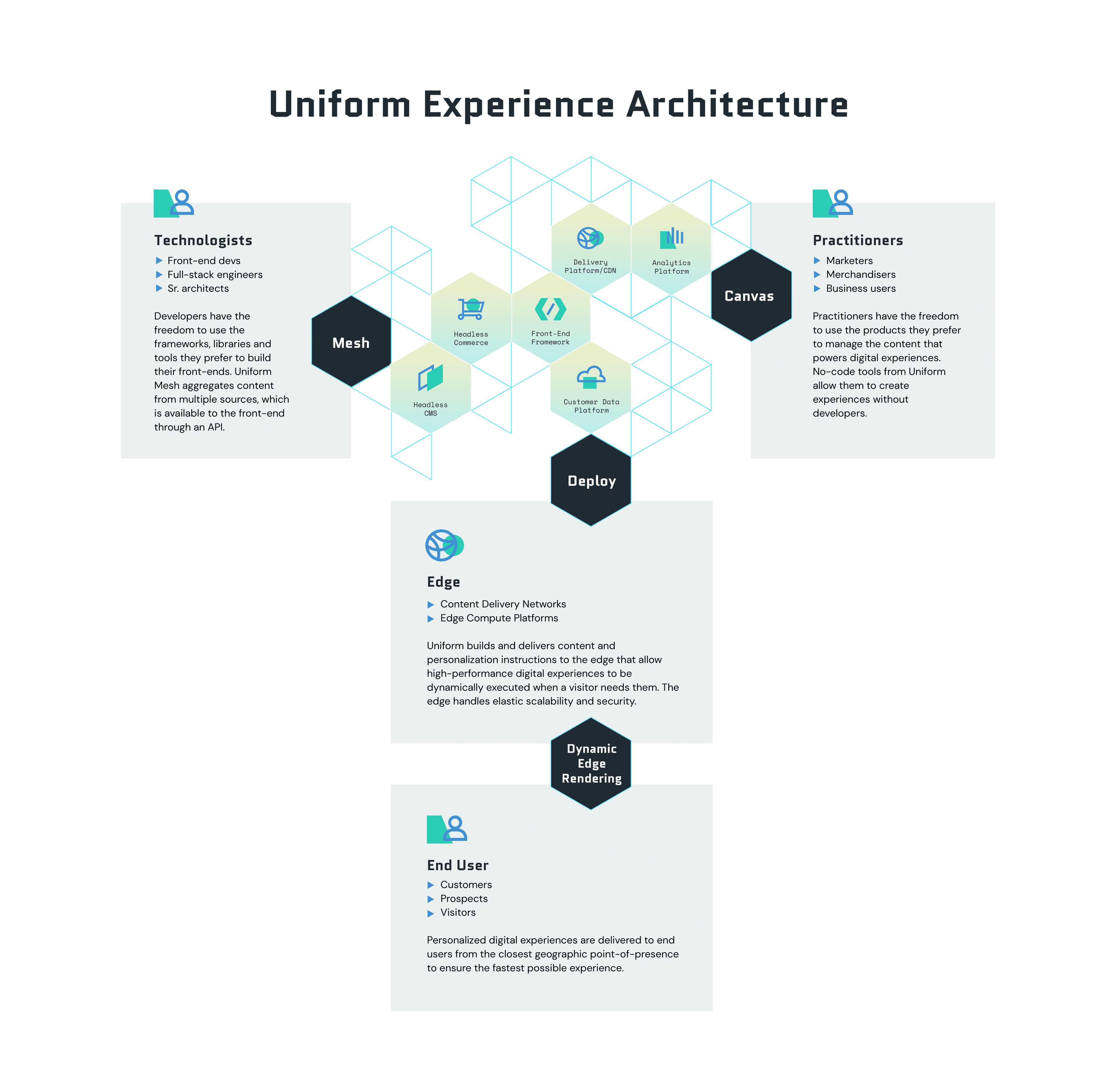
Leading with a value-first mindset
In the past, businesses were platform-first. You selected a DXP suite, picked an agency that specialized in that suite, and then followed niche implementation paradigms of that suite to build a rigid solution.
Uniform unlocks the value-first approach. You can start building your project immediately using the tools your developers love. Uniform connects those tools to create a truly composable DXP based on choice, allowing all of the teams that contribute to digital production to focus on what they do best and allowing digital experiences to be delivered as fast as physically possible from the edge of choice.
This value-first approach also allows Uniform to help business realize a sustainable digital experience platform. You can keep adding or removing headless tools without rebuilding everything from scratch, and those headless tools can co-exist as long as you need them to. It’s the end of re-platforming as we know it. And it’s not only good for the business, but it’s also good for our environment - replacing complex monolithic suites with modern tools saves the energy consumed by large legacy infrastructures.
With our Series A investment, we’ll be able to continue evolving how we help the world’s leading businesses realize fast, adaptable, and efficient digital delivery pipelines that deliver real sustainable value.
To do that, we’ll invest in strategic partnerships with leading headless vendors and visionary agencies. We’ll extend our toolsets for the developers on the frontlines of digital innovation. And we’ll empower marketers and merchants to build, launch, and optimize the digital experiences powering today’s most competitive businesses.
As we scale, we’re looking for the industry’s best and brightest digital innovators to join us. Take a look at our Careers page and reach out if you want to join the team.





